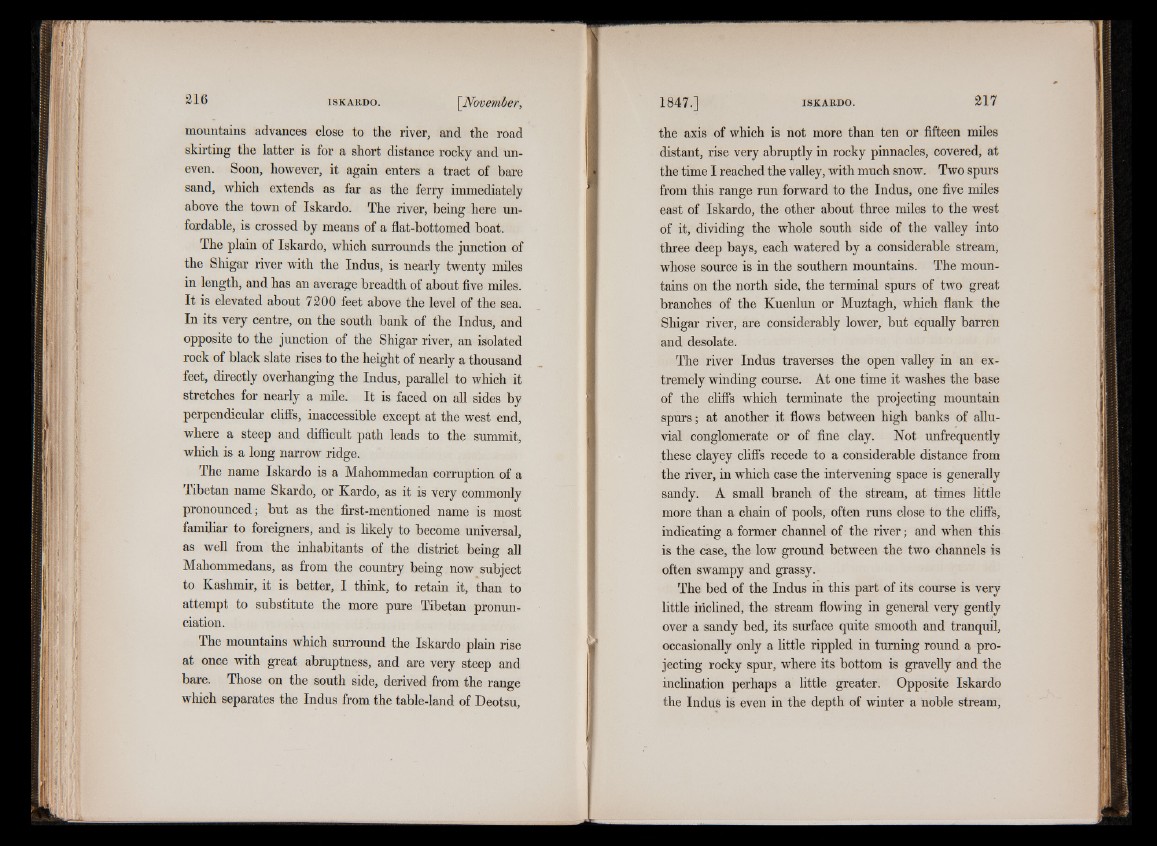
mountains advances close to the river, and the road
skirting the latter is for a short distance rocky and uneven.
Soon, however, it again enters a tract of bare
sand, which extends as far as the ferry immediately
above the town of Iskardo. The river, being here un-
fordable, is crossed by means of a flat-bottomed boat.
The plain of Iskardo, which surrounds the junction of
the Shigar river with the Indus, is nearly twenty miles
in length, and has an average breadth of about five miles.
It is elevated about 7200 feet above the level of the sea.
In its very centre, on the south bank of the Indus, and
opposite to the junction of the Shigar river, an isolated
rock of black slate rises to the height of nearly a thousand
feet, directly overhanging the Indus, parallel to which it
stretches for nearly a mile. It is faced on all sides by
perpendicular cliffs, inaccessible except at the west end,
where a steep and difficult path leads to the sum m it
which is a long narrow ridge.
The name Iskardo is a Mahommedan corruption of a
Tibetan name Skardo, or Kardo, as it is very commonly
pronounced; but as the first-mentioned name is most
familiar to foreigners, and is likely to become universal,
as well from the inhabitants of the district being all
Mahommedans, as from the country being now subject
to Kashmir, it is better, I think, to retain it, than to
attempt to substitute the more pure Tibetan pronunciation.
The mountains which surround the Iskardo plain rise
at once with great abruptness, and are very steep and
bare. Those on the south side, derived from the range
which separates the Indus from the table-land of Deotsu,
the axis of which is not more than ten or fifteen miles
distant, rise very abruptly in rocky pinnacles, covered, at
the time I reached the valley, with much snow. Two spurs
from this range run forward to the Indus, one five miles
east of Iskardo, the other about three miles to the west
of it, dividing the whole south side of the valley into
three deep bays, each watered by a considerable stream,
whose source is in the southern mountains. The mountains
on the north side, the terminal spurs of two great
branches of the Kuenlun or Muztagh, which flank the
Shigar river, are considerably lower, but equally barren
and desolate.
The river Indus traverses the open valley in an extremely
winding course. At one time it washes the base
of the cliffs which terminate the projecting mountain
spurs; at another it flows between high banks of alluvial
conglomerate or of fine clay. Not unfrequently
these clayey cliffs recede to a considerable distance from
the river, in which case the intervening space is generally
sandy. A small branch of the stream, at times little
more than a chain of pools, often runs close to the cliffs,
indicating a former channel of the river; and when this
is the case, the low ground between the two channels is
often swampy and grassy.
The bed of the Indus in this part of its course is very
little inclined, the stream flowing in general very gently
over a sandy bed, its surface quite smooth and tranquil,
occasionally only a little rippled in turning round a projecting
rocky spur, where its bottom is gravelly and the
inclination perhaps a little greater. Opposite Iskardo
the Indus is even in the depth of winter a noble stream,